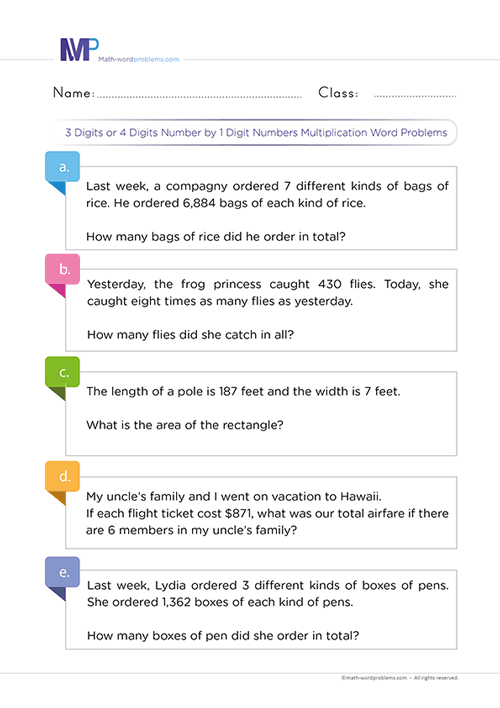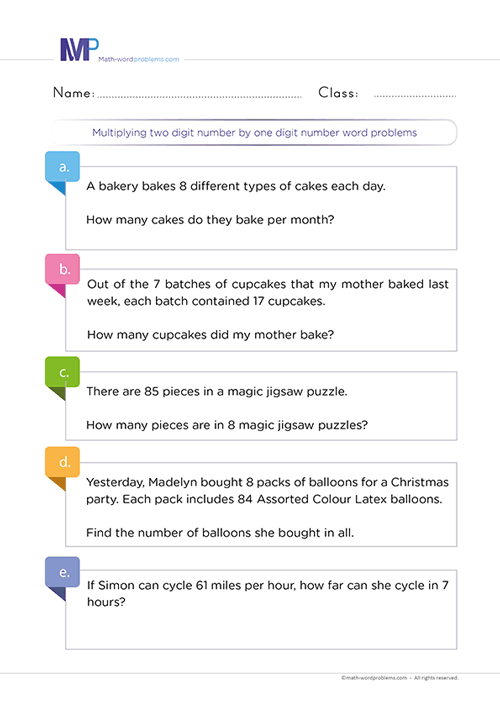 How do you solve 3-digit or 4-digits numbers by 1-digit numbers multiplication word problems?
How do you solve 3-digit or 4-digits numbers by 1-digit numbers multiplication word problems?
Grab a genuine experience on how do you solve 3-digit or 4-digits numbers by 1-digit numbers multiplication word problems. To perfectly enhance your kid's multiplication problem-solving skills, we will provide simple strategies, methods, and tips for reading and progressively solving the problem to arrive at an accurate answer.
All these skills will positively influence your kids' performance in sorting out essential keywords in word problems, analyzing, writing a problem's equation, and solving effectively.
In addition, we will consider the difficulty level of more complex multiplication word problems by providing fun techniques that kids can use to solve 3-digit or 4-digits numbers by 1-digit numbers multiplication word problems.
Steps on how to multiply 3-digit or 4-digits numbers by 1-digit numbers word problems
Your kids will have a memorable time with our steps on how to multiply 3-digit or 4-digit numbers by 1-digit numbers word problems.
It is interesting to note that we are here to take care of all the difficulties kids face when solving 3-digit or 4-digits numbers by 1-digit numbers multiplication word problems.
We are equally assuring you that, after your kids go through these steps, their cognitive skills and confidence in handling word problems will improve so much that they can effectively solve any challenging problem that they will encounter.
To show kids how these steps work, we will add some thrilling and fun real-life scenarios as examples below.
Step 1: IDENTIFY THE PROBLEM
To identify the problem, you must read the word problem very carefully to know exactly what the problem wants you to solve. You can do this by looking for important numbers and keywords in the word problem.
For instance, If you come across one of the following keywords in a word problem: - times, multiplied by, product, product of, factor, of, multiply, times, multiple, double, triple, groups, by, twice, area, equal groups, every, in all, total, increased by, as much, each, lots of, groups of, per, etc., then it implies that you have to perform a Multiplication Operation.
- ***One key Element for learners to understand is that they should not always rely on keywords alone. That is to say; the same keyword can have different meanings in different word problems.
- For this reason, we reiterate on the importance of reading the question very carefully to understand the situation that the word problem is describing, then figure out exactly which operation to use***
Step 2: STRATEGIZE OR GATHER RELEVANT INFORMATION
How will you solve or tackle the problem?
One key thing you must consider here is that each word problem requires a different format. Hence, the key points below will enable young math learners to tackle any format however it comes.
- As we mentioned in step 1 above, from the keyword(s) in the word problem, you can determine if you need to perform a Multiplication Operation.
- Note that you must not depend only on keywords. Also, try to understand the situation that the problem is describing.
- Now, after knowing the operation you will perform, construct short sentences to represent the given word problem.
Step 3: CREATE THE EQUATION
Moving on to this step, you will write down a numerical equation representing the information in the word problem.
Step 4 PROVIDE A SOLUTION
From step 3 above, multiply the numbers using regrouping or other multiplication methods like long multiplication, grid multiplication, or lattice to determine the final result. Remember to add the unit of measurement to the final result.
Step 5: CHECK YOUR WORK
Finally, check if your answer makes sense. For instance, estimate the answer and see if it is close to what you expected. However, if the answer is not what you expected, go back to step one and start all over again.
Examples on how to multiply 3-digits or 4-digits numbers by 1-digit numbers word problems
Example One
Step 1:After carefully reading the problem, the important numbers you’ll come across are 550 and 8. As you read further, the keywords that you’ll find in the problem are “how many,” “each,” and “altogether.”
Step 2:So, how are you going to tackle the problem?
As you can see, this is a typical example of the same keyword that can have different meanings in different word problems.
So, in this word problem, keywords alone are not enough to know the operation that you need to perform.
Therefore, in this case, you need to read the problem very well, i.e., use your reading comprehension skills here, and try to understand precisely what the problem wants you to solve.
After doing this, you’ll realize that the word problem requires a multiplication operation.
Next, after knowing which operation you will perform, form short sentences to represent the given word problem.
- Number of puzzles that my cousin has = 8
- Number of pieces that each puzzle has = 550
- Therefore, the total number of pieces = the number of pieces each puzzle has × the number of puzzles my cousin has.
Step 3:Here, write down a numerical equation to represent the bolded sentence in step 2 above to solve this word problem:
550 x 8 = ?
Step 4: From step 3 above, multiply the numbers using regrouping or any other multiplication method like long multiplication, grid multiplication, and lattice to determine the result. Always add the unit of measurement to your final answer, if any.
Using the long multiplication method, we will have
So, there were 4,400 puzzles altogether
Step 5: Finally, check if your answer makes sense. For instance, estimate the answer and see if it is close to what you expected. But, if the answer is not what you expected, go back to step one and start all over again.
Example Two
Step 1: Begin by carefully reading the problem to know exactly what the problem wants you to solve. After doing this, you’ll see that the important numbers here are $7,879 and 8. Also, the most important keyword(s) found in the word problem is “how much.”
Step 2: Now, how will you tackle the problem? From the situation that the problem is describing and the keywords found in the word problem, it implies that you have to perform a multiplication operation.
So, after knowing the operation you will perform, form short sentences to represent the given word problem.
- Amount of money that she earns per month = $7,879
- Given number of months = 8
- Therefore, the amount of money she will earn in 8 months = the amount she earns per month × the given number of months.
Step 3:Here, write down a numerical equation to represent the first bolded statement in step 2 above to be able to solve this word problem:
$7,879 × 8 = ?
Step 4:From step 3 multiply the numbers using regrouping or any other multiplication methods like long multiplication, grid multiplication, and lattice method to determine the result. Always recall adding the unit of measurement to your final answer.
Using the long multiplication method, we have
So, she will earn $63,032 in 8 months.
Step 5:Lastly, check if your answer makes sense. For example, estimate the answer and see if it is close to what you expected. However, if the answer is not what you expected, go back to step one and start all over again.





